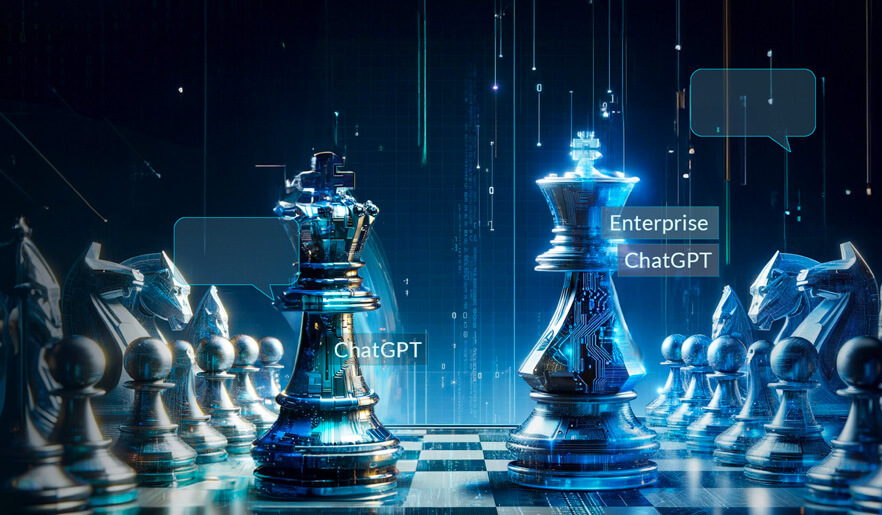In the ever-evolving landscape of artificial intelligence, natural language processing (NLP) has taken center stage, revolutionizing how we interact with computers and data. We find OpenAI’s ChatGPT and its more robust counterpart, Enterprise ChatGPT, at the forefront of this new revolution. In this blog, we discuss the technical background of both models, comparing their capabilities and potential applications.
ChatGPT:
Technical Scope:
ChatGPT is a versatile language model designed for a wide range of natural language understanding tasks. Its technical architecture is based on the GPT-3.5 architecture, with some tweaks to make it more suitable for conversational AI. Here’s a simplified breakdown of ChatGPT’s architecture:
Transformer Architecture: At its core, ChatGPT relies on the Transformer architecture, a neural network structure known for its ability to process sequential data efficiently.
Pretraining and Fine-Tuning: Like its predecessors, ChatGPT is pre-trained on a massive corpus of text data from the internet, which helps it learn grammar, facts, and reasoning abilities. It is then fine-tuned on specific datasets to adapt to tasks like text completion, question answering, and conversation.
GPT-3 Base: ChatGPT inherits the GPT-3 base model but undergoes further fine-tuning to improve its performance in a conversational context.
Enterprise ChatGPT:
Technical Scope:
Enterprise ChatGPT takes the foundation of ChatGPT and elevates it to meet the demands of complex, dynamic, and high-stakes conversational scenarios. Let’s explore its technical scope in detail:
Enhanced Pretraining:
- Domain-Specific Data: Unlike ChatGPT, which is pre-trained on a general dataset from the internet, Enterprise ChatGPT’s pretraining involves exposure to domain-specific data. This data may include industry-specific documents, customer interactions, legal contracts, medical records, or financial reports. This step helps the model acquire specialized knowledge of a particular field or industry.
Fine-Tuning with Custom Datasets:
- Customization: After the enhanced pretraining phase, Enterprise ChatGPT undergoes fine-tuning using custom datasets. These datasets are carefully curated to align with the specific goals and requirements of the enterprise. They may include historical customer support chat logs, industry-specific question-answer pairs, or proprietary documents.
- Adaptation: The fine-tuning process adapts the model to understand and generate relevant and contextually appropriate text within the enterprise’s domain. This adaptation is critical for ensuring the model’s accuracy and relevance in real-world applications.
Multi-Modal Inputs:
- Text, Images, Documents: Enterprise ChatGPT is equipped to handle multi-modal inputs, which means it can process and generate responses based on various data types. This capability allows it to analyze and respond to text, images, documents, or a combination of these inputs. For example, it can interpret medical images, extract information from financial reports, or provide explanations based on text and diagrams.
Contextual Memory:
- Long Conversations: Enterprise ChatGPT has an extended contextual memory compared to ChatGPT. It can remember and reference earlier parts of a conversation, allowing it to maintain context and provide more coherent and contextually relevant responses in long and complex discussions. This is especially valuable in customer support scenarios or legal consultations.
Compliance and Security:
- Privacy and Data Handling: Enterprise ChatGPT often includes robust privacy and security features to protect sensitive information. This may involve mechanisms for redacting or anonymizing data, ensuring compliance with industry regulations and privacy standards like GDPR or HIPAA.
Integration Capabilities:
- APIs and Integrations: Enterprise ChatGPT can be integrated into existing enterprise systems and applications through APIs. This facilitates seamless communication between the model and other software, making deploying it in various business processes and workflows easier.
Quality Control:
- Human Review and Feedback Loop: Many enterprise deployments of ChatGPT involve a continuous feedback loop with human reviewers who monitor and improve the quality of responses. This iterative process helps train the model further and ensures that it aligns with the enterprise’s specific standards and requirements.
In summary, Enterprise ChatGPT’s technical architecture is tailored to cater to the unique demands of businesses and organizations by incorporating enhanced pretraining, fine-tuning on custom datasets, support for multi-modal inputs, extended contextual memory, compliance features, integration capabilities, and quality control mechanisms. These elements collectively empower Enterprise ChatGPT to excel in domain-specific applications and provide valuable assistance in various enterprise use cases.
| Advantages | Disadvantages | |
| ChatGPT | Versatility for various NLP tasks | Lack of specialization |
| Easy integration via OpenAI’s API | Limited context retention | |
| Cost-effective solution for general tasks | Potential inaccuracy | |
| Broad knowledge base | Generic tone | |
| Quick deployment | Dependency on fine-tuning | |
| Enterprise ChatGPT | Domain expertise | Specialization limits versatility |
| Customization for specific needs | Complex deployment | |
| Multi-modal support | Higher cost considerations | |
| Contextual memory for long conversations | Human oversight may be required | |
| Compliance and security features | Training data availability challenges |
The Battle of Use Cases
Now that we’ve dissected the technical architectures of both models, it’s time to consider their potential applications.
ChatGPT: ChatGPT is ideal for general-purpose natural language understanding tasks. It can assist with drafting emails, answering trivia questions, and generating creative content. However, its limitations become evident in more specialized domains, where its responses may lack precision and context.
Enterprise ChatGPT: Enterprise ChatGPT shines in industries like healthcare, finance, legal, and customer support. Its fine-tuning of industry-specific data and multi-modal input support make it invaluable for applications like medical diagnosis, financial advisory, contract analysis, and customer issue resolution.
Choose When to Use WHAT
The choice between ChatGPT and Enterprise ChatGPT depends on the intended use case. While ChatGPT is a versatile conversational AI model suitable for various tasks, Enterprise ChatGPT steps up the game for organizations looking to leverage NLP for domain-specific, high-value applications. Understanding the technical nuances of these models is crucial for making an informed decision that aligns with your organization’s goals.
In the rapidly evolving world of NLP, ChatGPT and Enterprise ChatGPT represent significant strides towards enhancing human-computer interactions. As these models continue to evolve, we can expect even more exciting developments on the horizon.



